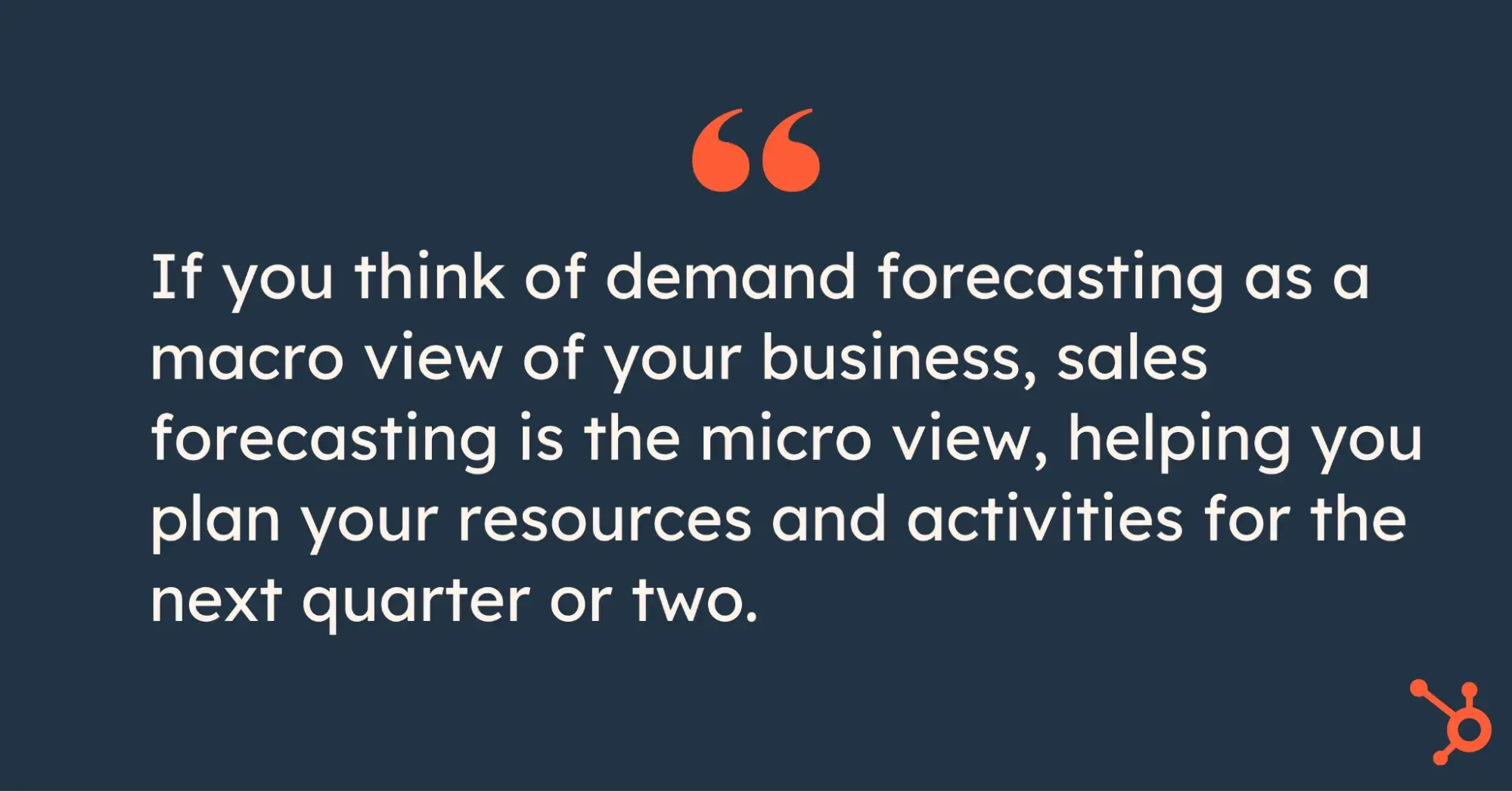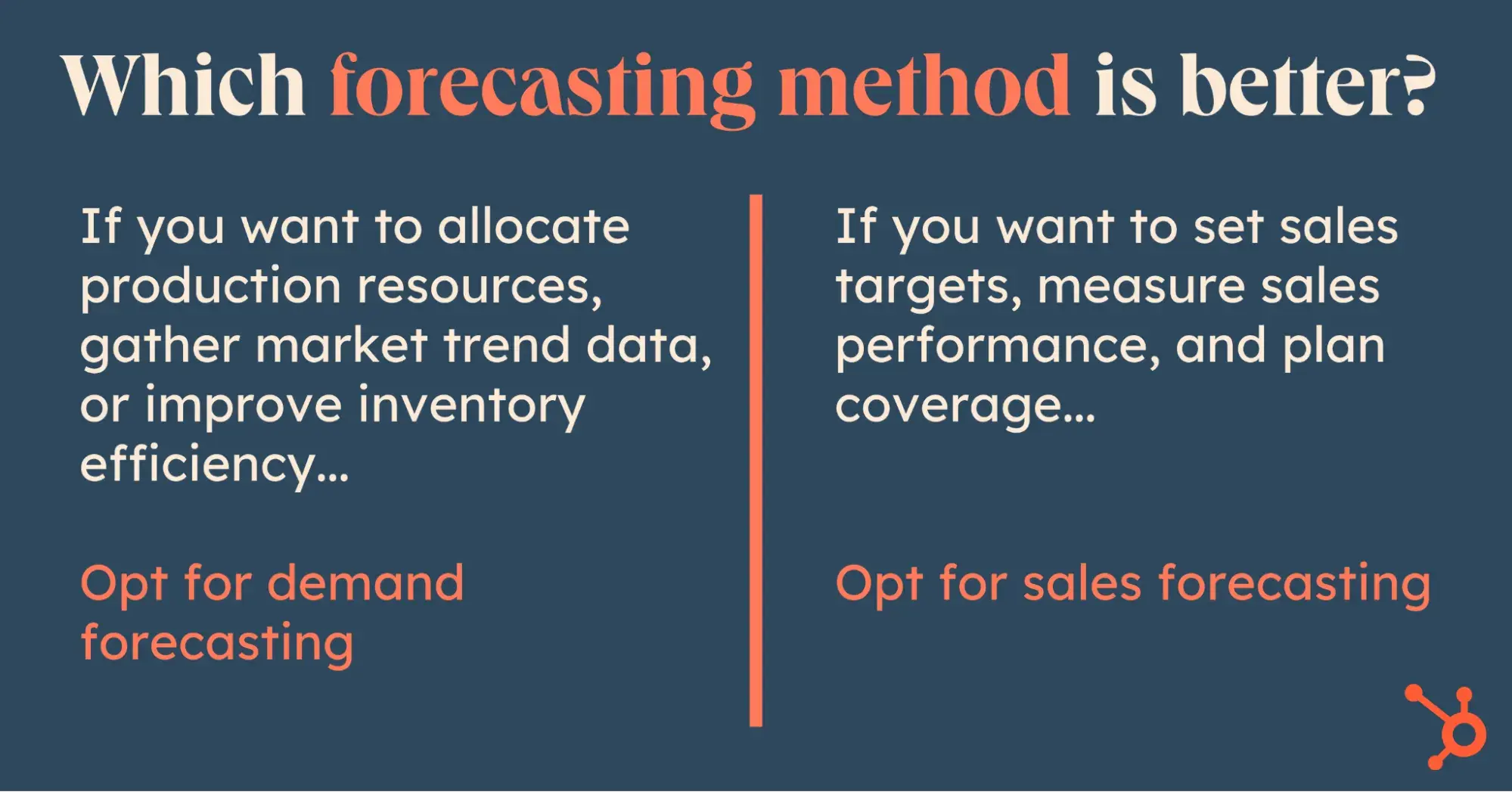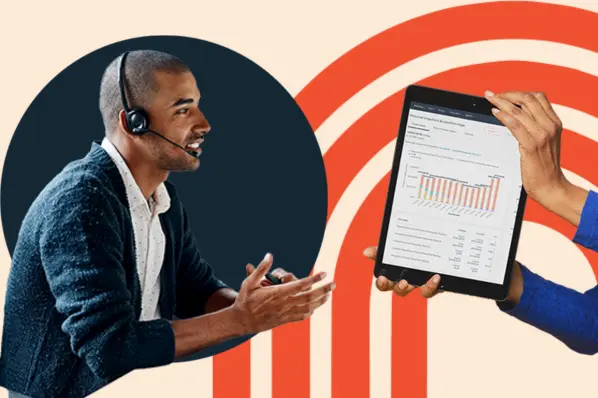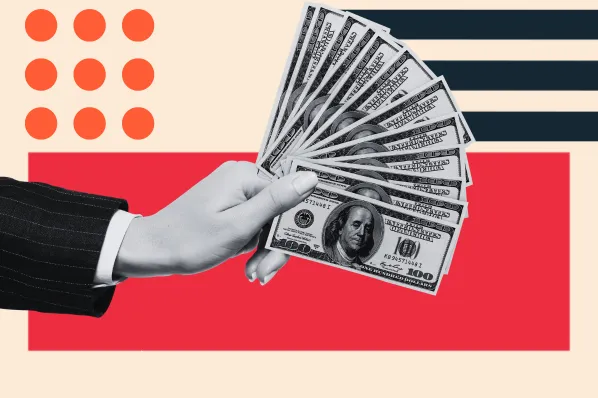Yet these teams didn’t just monitor their own forecasts to be successful. They collaborated with their counterparts and shared ownership of exceeding both sets of forecasts instead of simply “staying in their lane.”
Forecasting, as you’ll see in this article, is a multi-faceted tool for making informed business decisions. Let’s start by defining the different forecasting types. Then, I’ll explain how they work together, and share expert tips for using both forecasting methods successfully.
Table of Contents
- What Is Demand Forecasting?
- What Is Sales Forecasting?
- Demand Forecasting vs. Sales Forecasting
- Which Forecasting Method Is Better?
What Is Demand Forecasting?
While demand forecasting itself can be challenging, the definition is quite simple.
Demand forecasting estimates future product or service demand by analyzing:
- Market and economic conditions
- Global events
- Consumer behavior
- Market trends like customer preference changes
- Disruptive
- Competitor activities
For example, demand forecasting can help manufacturers predict how many units their customers will want to purchase based on historical trends. It helps project managers and services principals to schedule and recruit consultants or engineers based
In professional services businesses, “units” can refer to specific types of projects or hours. For a content marketing agency, a unit might refer to:
- A retainer
- A brand messaging guide
- New website copy
- A content strategy meeting
In this case, having enough “supply” means ensuring the agency has sufficient bandwidth or resources to manage the project pipeline.
Kali Bennett owns The Waterworks, an Alaska-based hot tub business that sells hot tubs, saunas, and swim spas. She says, “In my business, demand forecasting means understanding how much product I need on hand and on order at any given time while balancing the logistical challenges of shipping to Alaska.”
The biggest takeaway here is that demand forecasting boils down to predicting ebbs and flows — and planning accordingly for capacity or inventory. Best of all, with AI and machine learning, demand forecasts are becoming increasingly accurate. According to a Gartner survey, 45% of companies already use AI in demand forecasting and another 43% plan to implement it in the coming years.
Demand Forecasting Opportunities
Generally speaking, demand forecasting helps you better understand your business and target market and your team’s ability to meet customer demand. Ultimately, the more you know about your ideal customer profile, their purchasing patterns, and what motivates them, the easier it is to predict surges and slowdowns.
Some of the advantages of demand forecasting include:
- Improved inventory management.
- More efficient supply chain practices.
- More effective staffing practices and capacity planning.
- Better pricing strategies.
- More effective sales and marketing.
- Improved financial decisions.
What demand forecasting looks like varies dramatically depending on your business, but one thing is clear: Every industry has cyclical patterns that make it easier to start forecasting demand.
Christy Pyrz, CMO of Paradigm Peptides, shares that demand forecasting “helps with marketing campaigns and product launch timing and aids in inventory management, product development, and pricing.”
Demand Forecasting Challenges
In my experience, demand forecasting is essential for understanding year-over-year consumer patterns and trends. Circumstances change rapidly in industries like healthcare and manufacturing. It can be challenging for marketing leaders to plan for extenuating circumstances that are beyond their control, such as supply chain disruptions, seasonality, and regulatory changes.
The pandemic is a recent and significant example of demand forecast volatility. Demand increased overnight for essential supplies while many channels of shipping ground to a halt, especially across borders. It caused long-lasting ripple effects in just about every industry, leading to supply headaches not just in the availability of retail products but also in the supplies needed to run a business.
Types of Demand Forecasting
- Passive demand forecasting looks at past data to predict future sales, keeping things simple by only accounting for internal factors that your business can control.
- Active demand forecasting uses data in near-real-time to forecast future sales, and includes external factors like the state of the market, current marketing strategies, and competitive intelligence.
The pandemic was an outlier, yet it illustrates the various factors that can affect demand. Even the best forecasting applications aren’t magic crystal balls. At some point, demand forecasting can be skewed by unusual circumstances.
Expert Tips for Demand Forecasting
Understanding how to make the most of demand forecasting starts with paying attention to people who have been in the trenches.
Tip 1: Demand forecasting is not “go big or go home.”
In my experience, don’t try to create an exhaustive forecast when you are a demand forecasting rookie. Instead, start small, and assess year-over-year trends. As you start to identify patterns, you can get increasingly granular and layer new data sets into your forecasting model.
Tip 2: Qualitative insights are critical.
Jason Smit of Contentellect shares, “I recommend gathering qualitative insights across the customer journey to supplement quantitative data. Talking to customers, prospects, and account managers provides context no spreadsheet can.”
Tip 3: Be an expert in your product and market.
Gauri Manglik, CEO & co-founder of Instrumentl, adds, “The best way to do [demand forecasting] is to be as accurate as possible, which means knowing your market and your product inside and out. And it’s important to keep in mind that this isn’t just about predicting how many people want something — it's also about predicting when they want it.”
Tip 4: Demand forecasting is not one-and-done.
Finally, Debbie Moran of RecurPost reminds us, “Markets are dynamic, and demand can change rapidly. Regularly updating and refining forecasts is essential for staying ahead in a competitive environment.”
What Is Sales Forecasting?
We’ve talked about demand forecasts and the circumstances that influence them. Now let’s shift gears to sales. Where demand forecasting is about the number of units you should anticipate selling, sales forecasting focuses on how much revenue you’ll bring in from selling those units.
I’ve created many sales forecasts over the years, and keeping deals moving in the right direction can be like herding cats if you don’t have realistic and timely knowledge of where your deals stand. It’s painful when committed deals don’t close on schedule, so I learned to underpromise and overdeliver as much as possible.
Sales forecasting predicts a company’s future sales, setting targets, and organizing resources based on:
- Historical sales data
- Current market conditions
- Overall industry sales trends and economic conditions
- Competitor
- Global events like natural disasters or shifting political climates
- Company reputation
They inform production planning, inventory management, and supply chain operations.
Sales Forecasting Opportunities
Sales forecasting is a good strategy for businesses of all sizes across all industries. It helps businesses to be prepared for changing circumstances and for implementing SMART goals like:
- Opportunity and closed revenue
- Customer acquisitions
- Customer renewals and deal size increases
- Securing seed and growth funding based on realistic projections
- Making data-informed operational decisions, including new hires and product line expansion
Sales Forecasting Challenges
According to a 2022 Gartner survey, 67% of sales operations leaders say that sales forecasting is harder than three years ago.
While it’s reasonable to assume that the pandemic is a significant factor in this, it’s also important to recognize that today’s landscape is significantly more dynamic than in the past.
Like demand forecasting, many of the disadvantages lie in external factors out of your control. Some specific to sales forecasting might include:
- New competitors or products on the market.
- Economic factors that cause people to tighten their purse strings.
- Local, national, or global events.
Maintaining your sales forecasts means paying attention to what’s going on around you and adapting your predictions accordingly.
Expert Tips for Sales Forecasting
Sales forecasting can be tricky — but I’ve rounded up some tips to make it simpler for your business.
Tip 1: Think of sales forecasting as an opportunity.
In my experience, sales forecasting is a balancing act. You’ll need to plan for slow periods and busy periods and adapt your revenue plans accordingly to smooth out any dips. This might mean looking at new types of products or offers that draw in your audience during your “off-season.”
Tip 2: Sales forecasting is not something you can set and forget.
“Continuously monitor and adjust your forecasts to stay agile in the face of changing market conditions and customer behavior. It’s your roadmap to navigate the complex terrain of demand and sales in today’s business landscape,” says Marc Bishop, director of growth at WYTLABS.
Tip 3: Sales forecasting shouldn’t only be about the numbers.
Diving into the numbers can be a rabbit hole that’s both interesting and profitable. However, it doesn’t tell the whole story.
Gauri Manglik of Instrumentl cautions us not to forget about the customer experience, “As a business owner, it's important to remember that your customers are unique and deserve to be treated as such. You need to be able to look beyond what will make your business most profitable and think about what will make your customers happy and engaged with what you have to offer.”
Learn how to create and manage sales forecasts like the pros by reading The Ultimate Guide to Sales Forecasting.
Tip 4: Use purpose-built forecasting tools.
It’s also helpful to have the right tool, like HubSpot’s Sales Forecasting software.
Joe Earle of Dental Sky shares that his company uses HubSpot’s Sales Forecasting software to gain more visibility into their international sales pipeline. “Toggling between forecasts for different time ranges and being able to compare our monthly, quarterly and annual projections helps enormously with budget planning and capacity management,” Earle says.
If you use Sales Hub, learn how to use the forecasting and analytics tools with these Hubspot Academy lessons.
Now let’s explore how demand and sales forecasts strategically compare.
Demand Forecasting vs. Sales Forecasting
Demand and sales forecasting shouldn’t be managed in isolation because the factors that influence marketing also influence sales. It’s not a matter of choosing whether to prioritize demand forecasting over sales forecasting: both strategies have a place in your business.

Jason Smit of Contentellect offers a simple comparison, “In our business, demand forecasting takes a wider market view, while sales forecasting focuses on our specific pipeline. Demand models ensure we have enough creator capacity while sales forecasts keep pipelines moving.”
Another way of differentiating these forecasting approaches is that demand forecasting takes the long view of a company’s road ahead. Sales forecasting defines near-term goals, motivates sales tactics, and predicts outcomes.
If you think of demand forecasting as a macro view of your business, sales forecasting is the micro view, helping you plan your resources and activities for the next quarter or two.
Forecasts guide the way when markets are wild and competition is fierce
Sales and marketing must plan their resources and tactics based on demand — while also maintaining a thriving ecosystem of prospects and customers.
I like to think of the relationship between sales and marketing in the same way Mufasa from Disney’s The Lion King describes the Circle of Life.
Here’s the Circle of Revenue, if you will:
When Simba returned to Pride Rock, he learned hunger (demand) was rampant, and the competition was overhunting the Pride Lands. With new-found leadership skills and thought leadership, Simba and his allies — including seer (forecaster) Rafiki — eliminated the competition.
In other words, market demand and sales are the delicate balance that powers every company.
As each marketing campaign lifecycle completes, an audience is nurtured into leads for sales reps to pursue. When captured, leads transform into loyal customers whose success stories fuel marketing campaigns.
Which Forecasting Method Is Better?
Don’t you love it when you ask a question, and the answer is, “It depends, based on what you’re looking to achieve?”
If you do, you’re in luck.

Both of these forecast types are valuable for your business, but I have found that if you are looking to set sales targets, measure sales performance, and plan coverage, sales forecasting is your best bet.
If you are looking to allocate production resources, gather market trend data, or improve inventory efficiency, opt for demand forecasting. Or, create and manage both forecast types, and your business will be better for it.
Demand forecasting and sales forecasting aren’t mutually exclusive. Nor are they two sides of the same coin. While they may look quite similar, each strategy drives different insights making both valuable.
“Since the very beginning of our company, both demand forecasting and sales forecasting have been essential tools,” says José Moya, outreach manager at Capicua Full Stack Creative Hub.
Whether you are responsible for demand forecasting, sales forecasting, or both, Dental Sky’s Joe Earle reminds us to “use these forecasts directionally rather than as gospel. They help spot patterns and potential gaps to address. Real-world factors always influence outcomes too.”
Amplify Your Business Growth with Forecasting
Demand forecasting and sales forecasting can be valuable tools in every aspect of your decision-making process. The more accurate, realistic, and up-to-date your forecasts are, the better position you’ll be in to grow your business and navigate through dynamic market conditions.
Sales Forecasting
.png?width=112&height=112&name=Sales%20Conversion%20and%20Close%20Rate%20Calculator%2001-300%20(1).png)

.png)
![How to Choose the Right Forecasting Technique [+ Expert Insight and Data]](https://53.fs1.hubspotusercontent-na1.net/hubfs/53/forecasting-methods-1-20241205-4072635.webp)
-Feb-24-2025-07-49-23-4986-PM.png)







![I Took a Deep Dive Into Trend Forecasting: Here’s What I Learned [+ Expert Tips]](https://53.fs1.hubspotusercontent-na1.net/hubfs/53/trend-forecasting-1-20241114-1048511.webp)